Taking shape: Nendo redesigns Kenzo Tange offices and cafe in Tokyo
Nendo has turned interior architecture on its head in Kenzo Tange's Sogetsu Kaikan Tokyo building, where the renowned design studio has reimagined the Aoyama offices and Connel cafe.

Nendo has turned interior architecture on its head in Kenzo Tange's Sogetsu Kaikan Tokyo building, where the renowned design studio has reimagined the Aoyama offices and Connel cafe.
Rather than starting from the notion of 'interior functionality', Nendo was influenced and inspired by 'the exterior aesthetics' of the 1977 building. The half-mirrored curtain wall exterior and planar construction of the Sogetsu Kaikan has been cleverly matched with diagonal flooring, L-shaped lines and an overarching minimal aesthetic.
'The result is an interior design that allows one to get a strong sense of the character and form of the building as a whole,' explains the design studio.
The pleasing minimalism of the offices continues into the cafe, located on the second floor. Keeping Tange's original design untouched, it was the floor and furniture that received the Nendo treatment here. 'Stream' flooring has been fitted to smoothly unify the partitioned space, creating a sense of consistency throughout. Glossed black counters and refurbished 'Tulip Chairs' by Eero Saarinen do the same via furniture and fittings.
The cafe itself is chiefly managed by Nendo, inspired by their growing collaborations with a wide variety of people.
'We have named it “Connel”; a play on the Japanese word “koneru”, meaning “to knead” or “to mould”,' they explain. The word 'nendo' itself means clay, a pleasing parallel that they've expanded on to create the logo (by taking the Nendo 'n' and bending it into two 'c's). A playful take on the name and logo can be found in the cups themselves, which have unique, kneaded handles as well. All in all, a beautiful play on words, lines and style.

Inspired by 'the exterior aesthetics' of the 1977 building, Nendo looked to match the architecture with a visually appealing interior.

Japanese architect Kenzo Tange's Sogetsu Kaikan building, despite being built in 1977, remains relevant and pioneering.
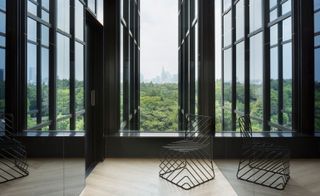
The half-mirrored curtain wall exterior and planar construction of the Sogetsu Kaikan have been cleverly matched with diagonal flooring, L-shaped lines and an overarching minimal aesthetic.
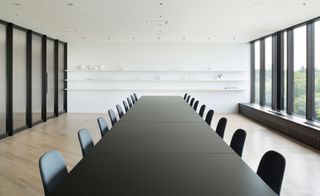
Large windows flood the meeting room and offices with light, making the spare furniture all the more effective.
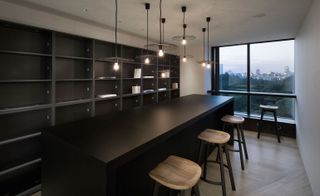
Meeting rooms, open-plan offices and smaller break out areas are fitted with different materials, making the space division clearer.
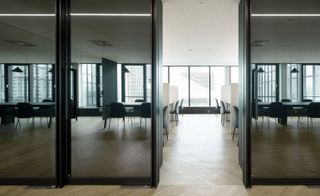
'The result is an interior design that allows one to get a strong sense of the character and form of the building as a whole,' explains the design studio.
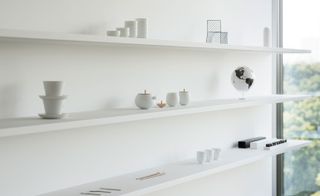
A view of the bookcase in the main meeting room.
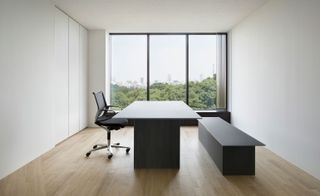
The Aoyama offices are surrounded by the verdant views of the adjacent Korekiyo Takahashi memorial park.
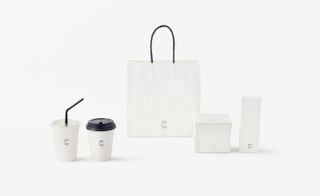
In addition to running Connel cafe, Nendo have also designed all the coffee ephemera.
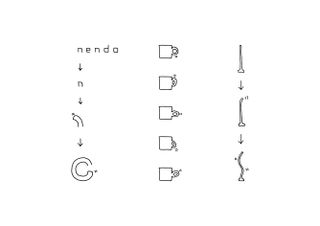
'We have named it “Connel”; a play on the Japanese word “koneru”, meaning “to knead” or “to mould”,' explain the coffee connoisseurs. The word 'nendo' itself means clay, a pleasing parallel that they've played with further to create the logo (taking the Nendo 'n' and bending it into two 'c's). Courtesy of Nendo
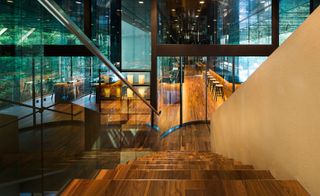
Keeping Tange's original design untouched, it was the floor and furniture that received the Nendo treatment in the cafe.

'Stream' flooring has been fitted to smoothly unify the partitioned space, creating a sense of consistency throughout.
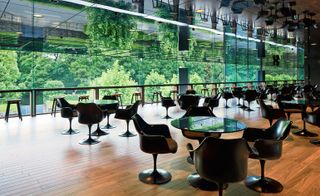
Glossed black counters and refurbished 'Tulip Chairs' by Eero Saarinen do the same through furniture and fittings.
Wallpaper* Newsletter
Receive our daily digest of inspiration, escapism and design stories from around the world direct to your inbox
-
 Ikea introduces its first gaming furniture collection
Ikea introduces its first gaming furniture collectionBrännboll is the first Ikea gaming furniture collection, unveiled during Milan Design Week 2024 and designed to swiftly transform a domestic space into a gamer’s paradise
By Jasper Spires Published
-
 Morgan take their classic roadster and give it subtle but significant tweaks for 2024
Morgan take their classic roadster and give it subtle but significant tweaks for 2024New details and features give the compulsive Morgan Plus Four an even more pared back silhouette and driving ability
By Jonathan Bell Published
-
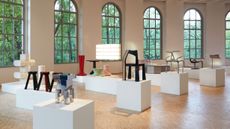 Wallpaper* Class of '24 exhibition now open at Triennale Milano
Wallpaper* Class of '24 exhibition now open at Triennale MilanoWallpaper* Class of '24 exhibition at Triennale spotlights international emerging talent in furniture and product design, with the support of AHEC and SNOW (until 21 April 2024)
By Rosa Bertoli Published
-
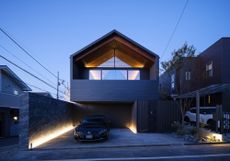 Modern Japanese houses inspiring minimalism and avant-garde living
Modern Japanese houses inspiring minimalism and avant-garde livingWe tour the best Japanese architecture and modern Japanese houses designed by international and local architects that open up possibilities for all types of lifestyle, from minimalist to communal in Japanese architecture.
By Ellie Stathaki Published
-
 An Aoyama House exemplifies a synergetic architect and client relationship
An Aoyama House exemplifies a synergetic architect and client relationshipA client’s faith in his architect pays dividends in Aoyama House; a light-filled, effortlessly elegant Tokyo home
By Jens H Jensen Published
-
 Tokyo home Le49Ⅱ brings together drama, domestic luxury and hybrid working habits
Tokyo home Le49Ⅱ brings together drama, domestic luxury and hybrid working habitsLe49Ⅱ by Japanese architects Apollo is a Tokyo home for a young family with hybrid working habits
By Ellie Stathaki Published
-
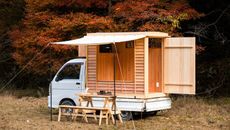 Takeshi Ikeuchi’s kei truck is a minimalist Japanese mobile showroom
Takeshi Ikeuchi’s kei truck is a minimalist Japanese mobile showroomTakeshi Ikeuchi's kei truck design is a Japanese timber specialist’s minimalist mobile showroom
By Jens H Jensen Published
-
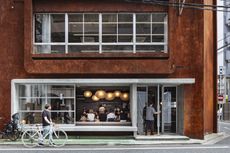 Nekoyacho Bldg is a Hiroshima office on a crossroads of 'food, work and entertainment'
Nekoyacho Bldg is a Hiroshima office on a crossroads of 'food, work and entertainment'Nekoyacho Bldg has been designed by Suppose Design Office as a 21st century workspace in Hiroshima, Japan
By Danielle Demetriou Published
-
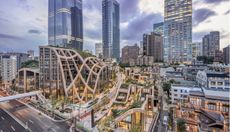 Heatherwick Studio’s Azabudai Hills district launches as Tokyo’s newest city-in-a-city
Heatherwick Studio’s Azabudai Hills district launches as Tokyo’s newest city-in-a-cityTokyo welcomes the Azabudai Hills district, designed by Heatherwick Studio and constructed as a city-in-a-city after over three decades of planning
By Danielle Demetriou Published
-
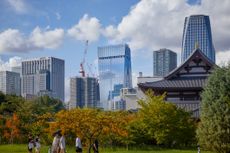 Toranomon Hills Station by OMA adds dynamism to the Tokyo skyline
Toranomon Hills Station by OMA adds dynamism to the Tokyo skylineToranomon Hills Station is OMA's first tower in Tokyo - as well as a project expanding and evolving the high rise typology
By Danielle Demetriou Published
-
 Terunobu Fujimori’s Kodomari Fuji guest house features a roof lined with cherry trees
Terunobu Fujimori’s Kodomari Fuji guest house features a roof lined with cherry treesCherry trees line the roof at Kodomari Fuji, Terunobu Fujimori's first accommodation facility design, a private guest house in Japan
By Joanna Kawecki Published